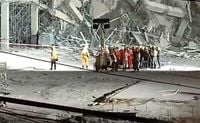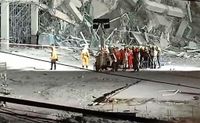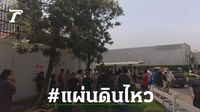On March 28, 2025, a powerful earthquake measuring 8.2 struck Myanmar, sending shockwaves that reverberated through northern Thailand and the capital city of Bangkok. The tremors caused significant alarm among residents, leading to widespread panic and a rush for safety. The hashtag '#แผ่นดินไหว' (earthquake) quickly trended at number one on Twitter (X) as people shared their experiences and reactions to the unprecedented event.
The earthquake, which lasted several minutes, was felt across various districts in Bangkok around 1:22 PM local time. Reports indicated that high-rise buildings swayed, and many residents evacuated their homes and offices in search of safety. Eyewitness accounts described the chaotic scenes, with individuals fleeing from tall structures and public transport systems like the BTS and MRT temporarily halting operations.
Videos circulating on social media depicted the panic and confusion that gripped the city. Clips showed people inside buildings, on public transport, and in the streets as they reacted to the shaking. Traffic jams ensued as commuters attempted to flee the city, and some buildings sustained damage, including a bridge connection between high-rises that collapsed.
As the news spread, social media became a vital tool for information dissemination. Users shared clips and images, expressing their fears and concerns about the earthquake's impact. The hashtag '#แผ่นดินไหว' not only highlighted the event but also served as a platform for discussions about earthquake preparedness and safety measures.
In the aftermath of the quake, many took to social media to reflect on the lessons learned from the incident. Users emphasized the importance of having effective warning systems, conducting drills, and educating the public about earthquake responses, especially in regions that may not have experienced such events before. This conversation underscored the need for robust infrastructure that can withstand seismic activity, particularly in Bangkok, which is known for its numerous high-rise buildings.
Experts have pointed out that the earthquake serves as a wake-up call for the city. Bangkok's infrastructure, including public transport systems like the BTS and MRT, must be thoroughly inspected and reinforced to handle potential seismic events in the future. The urgency for building designs to incorporate earthquake-resistant features has never been more apparent.
As residents shared their thoughts and experiences, many expressed a sense of vulnerability. The earthquake's magnitude and the resulting panic led some to question the reliability of technology during emergencies. "If there is too much fear, it will make things worse," one user commented, highlighting the need for clear communication and reliable information during crises.
Despite the chaos, the role of social media in providing timely updates and facilitating discussions was evident. Platforms like Twitter (X) allowed users to share real-time information and support each other in navigating the uncertainty. This aspect of social media proved crucial in reducing anxiety and fostering a sense of community among those affected.
As the dust settles, the incident raises important questions about disaster preparedness in urban settings. The earthquake not only impacted the immediate vicinity but also served as a reminder of the interconnectedness of regions in the face of natural disasters. The lessons learned from this event will likely shape future policies and practices regarding earthquake readiness in Thailand.
In conclusion, the earthquake that struck Myanmar and resonated throughout Thailand has sparked a nationwide conversation about safety, preparedness, and resilience. As the country reflects on this event, it is clear that proactive measures must be taken to ensure that cities like Bangkok are equipped to handle such challenges in the future.






